Neural Networks and Deep Learning(week2)Logistic Regression with a Neural Network mindset(实现一个图像识别算法)
Logistic Regression with a Neural Network mindset
You will learn to:
- Build the general architecture of a learning algorithm, including:
- Initializing parameters(初始化参数)
- Calculating the cost function and its gradient(计算代价函数,和他的梯度)
- Using an optimization algorithm (gradient descent)(使用梯度下降优化算法)
- Gather all three functions above into a main model function, in the right order.
1 - Packages(导入包,加载数据集)
其中,用到的Python包有:
- numpy 是使用Python进行科学计算的基础包。
- h5py Python提供读取HDF5二进制数据格式文件的接口,本次的训练及测试图片集是以HDF5储存的。
- matplotlib 是Python中著名的绘图库。
- PIL (Python Image Library) 为 Python提供图像处理功能。
- scipy 基于NumPy来做高等数学、信号处理、优化、统计和许多其它科学任务的拓展库。
import numpy as np
import matplotlib.pyplot as plt
import h5py
import scipy
from PIL import Image
from scipy import ndimage
from lr_utils import load_dataset # 用来导入数据集的
%matplotlib inline #设置matplotlib在行内显示图片
%load lr_utils.py, 如果该作业在本地运行,该代码保存在 lr_utils.py文件,和当前项目保存在一个文件夹下
import numpy as np
import h5py
def load_dataset():
train_dataset = h5py.File('datasets/train_catvnoncat.h5', "r")
train_set_x_orig = np.array(train_dataset["train_set_x"][:]) # your train set features
train_set_y_orig = np.array(train_dataset["train_set_y"][:]) # your train set labels
test_dataset = h5py.File('datasets/test_catvnoncat.h5', "r")
test_set_x_orig = np.array(test_dataset["test_set_x"][:]) # your test set features
test_set_y_orig = np.array(test_dataset["test_set_y"][:]) # your test set labels
classes = np.array(test_dataset["list_classes"][:]) # the list of classes
train_set_y_orig = train_set_y_orig.reshape((1, train_set_y_orig.shape[0]))
test_set_y_orig = test_set_y_orig.reshape((1, test_set_y_orig.shape[0]))
return train_set_x_orig, train_set_y_orig, test_set_x_orig, test_set_y_orig, classes
2 - Overview of the Problem set(目标:预处理数据)
Problem Statement: You are given a dataset ("data.h5") containing:
- a training set of m_train images labeled as cat (y=1) or non-cat (y=0)
- a test set of m_test images labeled as cat or non-cat
- each image is of shape (num_px, num_px, 3) where 3 is for the 3 channels (RGB). Thus, each image is square (height = num_px) and (width = num_px).
2.1 导入数据
# Loading the data (cat/non-cat)
train_set_x_orig, train_set_y, test_set_x_orig, test_set_y, classes = load_dataset()
2.2 熟悉数据
-
我们打算预处理这些数据,重新命名数据为 train_set_x, test_set_x。标签数据没必要预处理
-
train_set_x 和 test_set_x 是一个数组,代表一个图像,你可以运行下面代码预览一个例子,也可以通过修改索引查看其它图片)
# Example of a picture
index = 25
plt.imshow(train_set_x_orig[index])
print ("y = " + str(train_set_y[:,index]) + ", it's a '" + classes[np.squeeze(train_set_y[:,index])].decode("utf-8") + "' picture.")
- 许多深度学习里的bug来自于矩阵/向量维度不匹配,如果你能保持你的矩阵/向量维度清晰,你可以消除很多bug
Exercise: Find the values for:
- m_train (number of training examples)
- m_test (number of test examples)
- num_px (= height = width of a training image)
-
计算训练集、测试集的大小以及图像的大小
### START CODE HERE ### (≈ 3 lines of code)
m_train = train_set_y.shape[1]
m_test = test_set_y.shape[1]
num_px = train_set_x_orig.shape[1]
### END CODE HERE ###
print ("Number of training examples: m_train = " + str(m_train))
print ("Number of testing examples: m_test = " + str(m_test))
print ("Height/Width of each image: num_px = " + str(num_px))
print ("Each image is of size: (" + str(num_px) + ", " + str(num_px) + ", 3)")
print ("train_set_x shape: " + str(train_set_x_orig.shape))
print ("train_set_y shape: " + str(train_set_y.shape))
print ("test_set_x shape: " + str(test_set_x_orig.shape))
print ("test_set_y shape: " + str(test_set_y.shape))
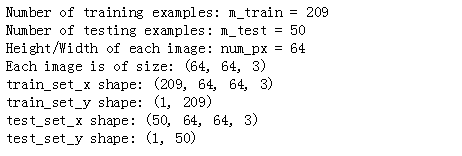
Expected Output for m_train, m_test and num_px:
| m_train | 209 |
| m_test | 50 |
| num_px | 64 |
2.3 转换矩阵
- 最终,整个训练集将会转为一个矩阵,其中包括num_px*num_py*3行,m_train列。
Exercise: Reshape the training and test data sets so that images of size (num_px, num_px, 3) are flattened into single vectors of shape (num_px ∗ num_px ∗ 3, 1).
其中X_flatten = X.reshape(X.shape[0], -1).T可以:将一个维度为(a,b,c,d)的矩阵转换为一个维度为(b∗c∗d, a)的矩阵。
-
转换图像为一个矢量,即矩阵的一列
X_flatten = X.reshape(X.shape[0], -1).T # X.T is the transpose of X
# Reshape the training and test examples
### START CODE HERE ### (≈ 2 lines of code)
train_set_x_flatten = train_set_x_orig.reshape(train_set_x_orig.shape[0], -1).T
test_set_x_flatten = test_set_x_orig.reshape(test_set_x_orig.shape[0], -1).T
# 基础方法:需要的是 m_train 行 (shape[1]*shape[2]*shape[3]) 的数据, 所以需要转置,不知道为啥算出来和上面的方法不太一样。。。
# train_set_x_flatten = train_set_x_orig.reshape(train_set_x_orig.shape[1]*train_set_x_orig.shape[2]*train_set_x_orig.shape[3], train_set_x_orig.shape[0])
# test_set_x_flatten = test_set_x_orig.reshape(test_set_x_orig.shape[1]*test_set_x_orig.shape[2]*test_set_x_orig.shape[3], test_set_x_orig.shape[0])
### END CODE HERE ###
print ("train_set_x_flatten shape: " + str(train_set_x_flatten.shape))
print ("train_set_y shape: " + str(train_set_y.shape))
print ("test_set_x_flatten shape: " + str(test_set_x_flatten.shape))
print ("test_set_y shape: " + str(test_set_y.shape))
print ("sanity check after reshaping: " + str(train_set_x_flatten[0:5,0]))
# print ("sanity check after reshaping: " + str(train_set_x_flatten[:, :]))

Expected Output:
| train_set_x_flatten shape | (12288, 209) |
| train_set_y shape | (1, 209) |
| test_set_x_flatten shape | (12288, 50) |
| test_set_y shape | (1, 50) |
| sanity check after reshaping | [17 31 56 22 33] |
2.4 预处理数据(去中心化)
- 为了表示图像(RGB)必须指定为每个像素,实际上像素值就是三个数字组成的向量(0-255))
- 通常机器学习的预处理工作是 去中心化和标准化你的数据集, (x - mean)/标准差。但是对图像数据集,数据集的每一行除以255(最大值的像素通道)更简单方便高效)
train_set_x = train_set_x_flatten / 255.
test_set_x = test_set_x_flatten / 255.
What you need to remember:
常见的预处理一个新数据集的步骤是:
- Figure out the dimensions and shapes of the problem (m_train, m_test, num_px, ...)
- Reshape the datasets such that each example is now a vector of size (num_px * num_px * 3, 1)
- "Standardize" the data
3 - General Architecture of the learning algorithm(算法流程)
- 设计一个简单的算法来区分猫的猫图片的图像。
- 你将用神经网络的思想构建一个逻辑回归,下面的图像解释为什么逻辑回归实际上是一个非常简单神经网络!

算法的数学表达式:
对一个 样例 

计算所有训练样本代价:

Key steps: In this exercise, you will carry out the following steps:
初始化模型的参数
通过最小化代价来学习模型的参数
使用学习好的参数来进行预测(在测试集上)
分析结果并做总结
4 - Building the parts of our algorithm(构建算法的部分)
搭建一个神经网络的主要步骤:
- 定义模型结构(例如输入特征的数量)
- 初始化模型的参数
- 循环操作
- 计算当前的 loss 值(前向传播)
- 计算当前的梯度值(反向传播)
- 更新参数,梯度下降算法
你通常分别构建1-3.并把他们集成到一个model()函数中。
4.1 - sigmod()函数实现
Exercise: 实现 sigmod() 函数, 你需要计算 sigmoid(wTx+b) 来进行预测
# GRADED FUNCTION: sigmoid
def sigmoid(z):
"""
Compute the sigmoid of z
Arguments:
x -- A scalar or numpy array of any size.
Return:
s -- sigmoid(z)
"""
### START CODE HERE ### (≈ 1 line of code)
s = 1 / (1 + np.exp(-z))
### END CODE HERE ###
return s
print ("sigmoid(0) = " + str(sigmoid(0)))
print ("sigmoid(9.2) = " + str(sigmoid(9.2)))

4.2 - 初始化参数(w, b)
Exercise: 在下面实现参数初始化. 你不得不初始化 w 为一个零向量。使用 np.zeros().
# GRADED FUNCTION: initialize_with_zeros
def initialize_with_zeros(dim):
"""
This function creates a vector of zeros of shape (dim, 1) for w and initializes b to 0.
Argument:
dim -- size of the w vector we want (or number of parameters in this case)
Returns:
w -- initialized vector of shape (dim, 1)
b -- initialized scalar (corresponds to the bias)
"""
### START CODE HERE ### (≈ 1 line of code)
w = np.zeros(shape=(dim, 1)) # 初始化 w 为 (dim行,1列) 的向量
b = 0
### END CODE HERE ###
assert(w.shape == (dim, 1)) # 判断 w 的shape是否为 (dim, 1), 不是则终止程序
assert(isinstance(b, float) or isinstance(b, int)) # 判断 b 是否是float或者int类型
return w, b
Expected Output:
| w | [[ 0.] [ 0.]] |
| b | 0 |
对于图像输入,w的维度是 (num_px * num_px * 3, 1)。
4.3 - 前向传播 和 后向传播
现在你的参数已经初始化,可以进行 前向传播 和 后向传播 步骤来学习参数。
Exercise: 实现一个函数 propagate() 来计算 代价函数 和 他的梯度
Hints:
Forward Propagation:

Here are the two formulas you will be using:

# GRADED FUNCTION: propagate
def propagate(w, b, X, Y):
"""
Implement the cost function and its gradient for the propagation explained above
Arguments:
w -- weights, a numpy array of size (num_px * num_px * 3, 1)
b -- bias, a scalar
X -- data of size (num_px * num_px * 3, number of examples)
Y -- true "label" vector (containing 0 if non-cat, 1 if cat) of size (1, number of examples)
Return:
cost -- negative log-likelihood cost for logistic regression
dw -- gradient of the loss with respect to w, thus same shape as w
db -- gradient of the loss with respect to b, thus same shape as b
Tips:
- Write your code step by step for the propagation
"""
m = X.shape[1] # 样例数
# print(m)
# 前向传播(Forward Propagation) (FROM X TO COST)
### START CODE HERE ### (≈ 2 lines of code)
A = sigmoid(np.dot(w.T, X) + b) # 计算 activation , A 的 维度是 (m, m)
cost = (- 1 / m) * np.sum(Y * np.log(A) + (1 - Y) * (np.log(1 - A))) # 计算 cost; Y == yhat(1, m)
### END CODE HERE ###
# 反向传播(Backward Propagation) (TO FIND GRAD)
### START CODE HERE ### (≈ 2 lines of code)
dw = (1 / m) * np.dot(X, (A - Y).T) # 计算 w 的导数
db = (1 / m) * np.sum(A - Y) # 计算 b 的导数
### END CODE HERE ###
assert(dw.shape == w.shape) # 这些代码 会 减少bug出现
assert(db.dtype == float) # db 是一个值
cost = np.squeeze(cost) # 压缩维度,(从数组的形状中删除单维条目,即把shape中为1的维度去掉),保证cost是值
assert(cost.shape == ())
grads = {"dw": dw,
"db": db}
return grads, cost
w, b, X, Y = np.array([[1], [2]]), 2, np.array([[1,2], [3,4]]), np.array([[1, 0]])
grads, cost = propagate(w, b, X, Y)
print ("dw = " + str(grads["dw"]))
print ("db = " + str(grads["db"]))
print ("cost = " + str(cost))
Expected Output:
| dw | [[ 0.99993216] [ 1.99980262]] |
| db | 0.499935230625 |
| cost | 6.000064773192205 |
4.4 Optimization(最优化)
- 你已经初始化了你的参数。
- 你已经能够计算一个代价函数和他的梯度。
- 现在,你需要用梯度下降算法更新参数。
Exercise: 写下 optimization function(优化函数),目标是通过最小化代价函数 J,学习参数 w 和 b。对参数 θ,更新规则是 θ = θ - α dθ,α是 learning rate)
# GRADED FUNCTION: optimize
def optimize(w, b, X, Y, num_iterations, learning_rate, print_cost = False):
"""
This function optimizes w and b by running a gradient descent algorithm
Arguments:
w -- weights, a numpy array of size (num_px * num_px * 3, 1)
b -- bias, a scalar
X -- data of shape (num_px * num_px * 3, number of examples)
Y -- true "label" vector (containing 0 if non-cat, 1 if cat), of shape (1, number of examples)
num_iterations -- number of iterations of the optimization loop
learning_rate -- learning rate of the gradient descent update rule
print_cost -- True to print the loss every 100 steps
Returns:
params -- dictionary containing the weights w and bias b
grads -- dictionary containing the gradients of the weights and bias with respect to the cost function
costs -- list of all the costs computed during the optimization, this will be used to plot the learning curve.
Tips:
You basically need to write down two steps and iterate through them:
1) Calculate the cost and the gradient for the current parameters. Use propagate().
2) Update the parameters using gradient descent rule for w and b.
"""
costs = []
for i in range(num_iterations):
# Cost and gradient calculation
### START CODE HERE ###
grads, cost = propagate(w, b, X, Y)
### END CODE HERE ###
# Retrieve derivatives from grads(获取导数)
dw = grads["dw"]
db = grads["db"]
# update rule (更新 参数)
### START CODE HERE ###
w = w - learning_rate * dw # need to broadcast
b = b - learning_rate * db
### END CODE HERE ###
# Record the costs (每一百次记录一次 cost)
if i % 100 == 0:
costs.append(cost)
# Print the cost every 100 training examples (如果需要打印则每一百次打印一次)
if print_cost and i % 100 == 0:
print ("Cost after iteration %i: %f" % (i, cost))
# 记录 迭代好的参数 (w, b)
params = {"w": w,
"b": b}
# 记录当前导数(dw, db), 以便下次继续迭代
grads = {"dw": dw,
"db": db}
return params, grads, costs
params, grads, costs = optimize(w, b, X, Y, num_iterations= 200, learning_rate = 0.009, print_cost = True)
print ("w = " + str(params["w"]))
print ("b = " + str(params["b"]))
print ("dw = " + str(grads["dw"]))
print ("db = " + str(grads["db"]))
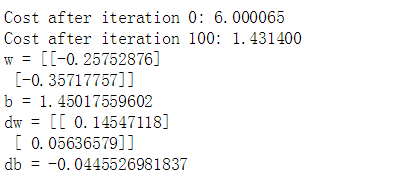
Exercise: 前面的函数 将输出学习好的参数 (w, b), 我们可以使用w和b来预测数据集 x 的标签,实现 predict() 函数。计算预测有两个步骤:
- 计算 Y_hat = A = sigmod(w.T X + b)
- 转换 a 为 0 (如果 activation <= 0.5) 或者 1 (如果activation > 0.5),存储预测值在 向量Y_prediction中。如果你想,你可以在for循环中使用 if/else(尽管有方法将其向量化)
# GRADED FUNCTION: predict
def predict(w, b, X):
'''
Predict whether the label is 0 or 1 using learned logistic regression parameters (w, b)
Arguments:
w -- weights, a numpy array of size (num_px * num_px * 3, 1)
b -- bias, a scalar
X -- data of size (num_px * num_px * 3, number of examples)
Returns:
Y_prediction -- a numpy array (vector) containing all predictions (0/1) for the examples in X
'''
m = X.shape[1]
Y_prediction = np.zeros((1, m))
w = w.reshape(X.shape[0], 1)
# Compute vector "A" predicting the probabilities of a cat being present in the picture
### START CODE HERE ### (≈ 1 line of code)
A = sigmoid(np.dot(w.T, X) + b)
### END CODE HERE ###
for i in range(A.shape[1]):
# Convert probabilities a[0,i] to actual predictions p[0,i]
### START CODE HERE ### (≈ 4 lines of code)
Y_prediction[0, i] = 1 if A[0, i] > 0.5 else 0
### END CODE HERE ###
assert(Y_prediction.shape == (1, m))
return Y_prediction
print("predictions = " + str(predict(w, b, X)))
Expected Output:
| predictions | [[ 1. 1.]] |
What to remember: You've implemented several functions that:
- 初始化参数 (w, b)
- 迭代优化 损失值 以学习参数(w,b) :
- 计算 代价值 和 他的梯度
- 用梯度下降算法更新参数
- 使用学习好的(w, b)来进行预测给定的 样本集标签
5 - 合并所有函数在一个model()里
你将看到如何通过将所有构建(在前面部分中实现的功能)按照正确的顺序组合在一起来构建整个模型。
Exercise: Implement the model function. Use the following notation:
- Y_prediction :你在测试集上进行预测
- Y_prediction_train:你在训练集上的预测
- w, costs, grads :optimize()的输出
# GRADED FUNCTION: model
def model(X_train, Y_train, X_test, Y_test, num_iterations=2000, learning_rate=0.5, print_cost=False):
"""
Builds the logistic regression model by calling the function you've implemented previously
Arguments:
X_train -- training set represented by a numpy array of shape (num_px * num_px * 3, m_train)
Y_train -- training labels represented by a numpy array (vector) of shape (1, m_train)
X_test -- test set represented by a numpy array of shape (num_px * num_px * 3, m_test)
Y_test -- test labels represented by a numpy array (vector) of shape (1, m_test)
num_iterations -- hyperparameter representing the number of iterations to optimize the parameters
learning_rate -- hyperparameter representing the learning rate used in the update rule of optimize()
print_cost -- Set to true to print the cost every 100 iterations
Returns:
d -- dictionary containing information about the model.
"""
### START CODE HERE ###
# initialize parameters with zeros (初始化参数(w, b))
w, b = initialize_with_zeros(X_train.shape[0]) # num_px*num_px*3
# Gradient descent (前向传播和后向传播 同时 梯度下降更新参数)
parameters, grads, costs = optimize(w, b, X_train, Y_train, num_iterations, learning_rate, print_cost)
# Retrieve parameters w and b from dictionary "parameters"(获取参数w, b)
w = parameters["w"]
b = parameters["b"]
# Predict test/train set examples (使用测试集和训练集进行预测)
Y_prediction_test = predict(w, b, X_test)
Y_prediction_train = predict(w, b, X_train)
### END CODE HERE ###
# Print train/test Errors (训练/测试误差: (100 - mean(abs(Y_hat - Y))*100 )
print("train accuracy: {} %".format(100 - np.mean(np.abs(Y_prediction_train - Y_train)) * 100))
print("test accuracy: {} %".format(100 - np.mean(np.abs(Y_prediction_test - Y_test)) * 100))
d = {"costs": costs,
"Y_prediction_test": Y_prediction_test,
"Y_prediction_train" : Y_prediction_train,
"w" : w,
"b" : b,
"learning_rate" : learning_rate,
"num_iterations": num_iterations}
return d
d = model(train_set_x, train_set_y, test_set_x, test_set_y, num_iterations = 2000, learning_rate = 0.005, print_cost = True)
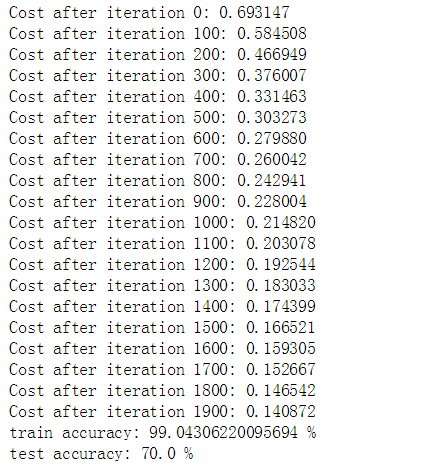

Comment: 训练集准确率接近 100%. 这是一个很好的检查:你的模型能够工作,并且有足够能力去拟合训练数据。 鉴于我们使用的小数据集和逻辑回归是一个线性分类器,测试误差 是 68%,这对这样简单的模型来说还不坏。
此为,你还可以看到,该模型显然对培训数据进行了过渡拟合。在这个专门化后面,你将学习如何减少过渡拟合。例如通过使用 正则化。使用下面的代码(更改索引变量),你可以查看测试集上图片的预测。
# Example of a picture that was wrongly classified.
index = 5
plt.imshow(test_set_x[:,index].reshape((num_px, num_px, 3)))
# test_set_y[0, index]:测试集里标签; classes[int(d["Y_Prediction_test"][0, index])]:预测值
print ("y = " + str(test_set_y[0, index]) + ", you predicted that it is a \"" +
classes[int(d["Y_prediction_test"][0, index])].decode("utf-8") + "\" picture.")
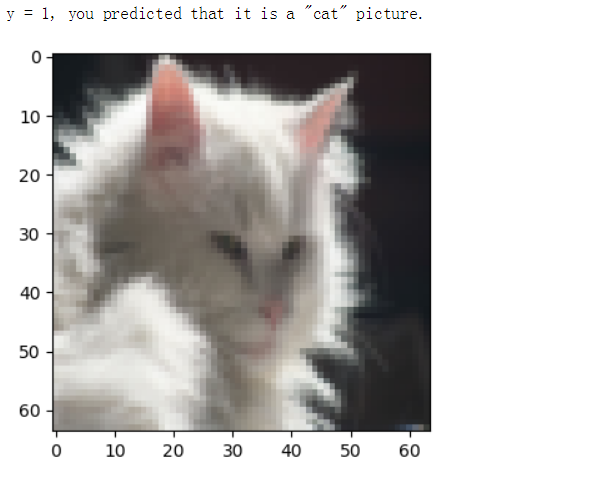
精确性不是很高。。。
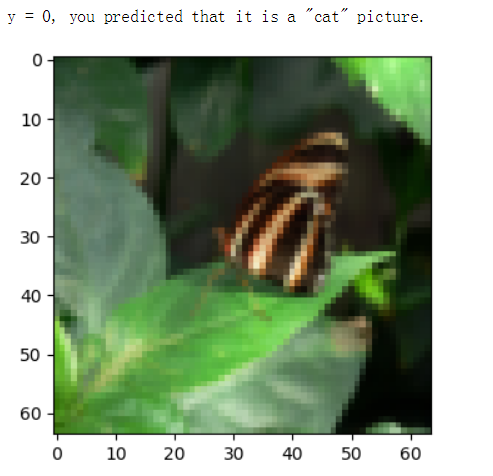
# Plot learning curve (with costs)
costs = np.squeeze(d['costs'])
plt.plot(costs)
plt.ylabel('cost')
plt.xlabel('iterations (per hundreds)')
plt.title("Learning rate =" + str(d["learning_rate"]))
plt.show()
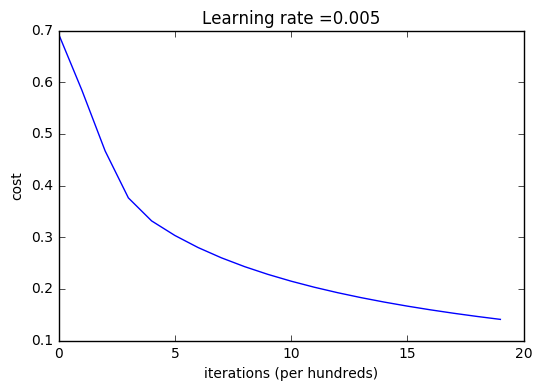
Interpretation: 你可以看见成本在下降。这表明参数正则学习中。但是你可以看到,你可以在训练集对模型进行更多的培训。尝试增加以上代码中的迭代次数,并重新运行代码。你会看见,训练集的准确性会提高,但是测试集的精度会下降。这就是过渡拟合。
6 - Further analysis
检查 learning rate α.的可能选择
选择一个learning rate α
Reminder:为了让梯度下降能够工作,你必须明智的选择learning rate α。α决定了我们更新参数的速度。如果学习率太高,我们可能会”超过”最优值。同样,如果他太小,我们将需要太多的迭代来收敛到最佳值。这就是为什么使用良好α至关重要。
让我们比较我们的模型的α与几种选择的α。
learning_rates = [0.01, 0.001, 0.0001]
models = {}
for i in learning_rates:
print ("learning rate is: " + str(i))
models[str(i)] = model(train_set_x, train_set_y, test_set_x, test_set_y, num_iterations = 1500, learning_rate = i, print_cost = False)
print ('\n' + "-------------------------------------------------------" + '\n')
for i in learning_rates:
plt.plot(np.squeeze(models[str(i)]["costs"]), label= str(models[str(i)]["learning_rate"]))
plt.ylabel('cost')
plt.xlabel('iterations')
legend = plt.legend(loc='upper center', shadow=True)
frame = legend.get_frame()
frame.set_facecolor('0.90')
plt.show()
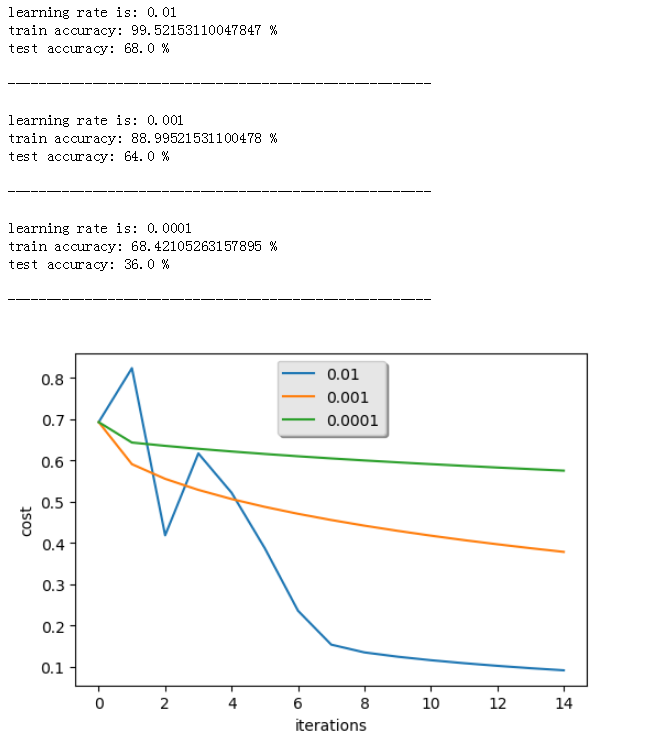
Interpretation:
- 不同α带来不同的cost,因此不同预测结果
- 如果学习率太高(0.01),cost可能上下波。(尽管本例中0.01还行)
- 更低的成本不意味着一个更好的模型。你需要检查一下是否可能过拟合。当训练精度远远高于测试精度时,就会过拟合!
- 在深度学习中,我们推荐
- 选择能够更好最小化代价的 learning rate
- 如果模型过拟合,选择其他技术减少过拟合,后面会讲!
7 - Test with your own image
你可以使用 你的图片 来测试 你的模型的输出。.做这些:
import imageio from skimage.transform import resize ## START CODE HERE ## (PUT YOUR IMAGE NAME) my_image = "my_image4.jpg" # 修改你图像的名字 ## END CODE HERE ## # We preprocess the image to fit your algorithm. fname = "images/" + my_image # 图片位置 image = np.array(imageio.imread(fname)) # 读入图片为矩阵, 这里用原版本的会出错,scipy的那个函数被删了 print(image.shape) # 转置图片为 (num_px*num_px*3, 1)向量 my_image = resize(image, output_shape=(num_px, num_px)).reshape((1, num_px * num_px * 3)).T print(my_image) my_predicted_image = predict(d["w"], d["b"], my_image) # 用训练好的参数来预测图像 plt.imshow(image) print(classes) print("y = " + str(np.squeeze(my_predicted_image)) + ", your algorithm predicts a \"" + classes[int(np.squeeze(my_predicted_image)),].decode("utf-8") + "\" picture.")
What to remember from this assignment:
- 预处理你的数据集很重要Preprocessing the dataset is important.
- 你分别实现每个函数: initialize(), propagate(), optimize(). 然后你整合成 一个 model().
- 调整你的learning rate (which is an example of a "hyperparameter") 可以对算法产生很大的影响.
代码综合
import numpy as np import matplotlib.pyplot as plt import h5py import scipy from PIL import Image from scipy import ndimage from lr_utils import load_dataset # 用来导入数据集的 import skimage %matplotlib inline # Loading the data (cat/non-cat) train_set_x_orig, train_set_y, test_set_x_orig, test_set_y, classes = load_dataset() ### START CODE HERE ### (≈ 3 lines of code) m_train = train_set_y.shape[1] # or train_set_x_orig.shape[0] m_test = test_set_y.shape[1] num_px = train_set_x_orig.shape[1] ### END CODE HERE ### print ("Number of training examples: m_train = " + str(m_train)) print ("Number of testing examples: m_test = " + str(m_test)) print ("Height/Width of each image: num_px = " + str(num_px)) print ("Each image is of size: (" + str(num_px) + ", " + str(num_px) + ", 3)") print ("train_set_x shape: " + str(train_set_x_orig.shape)) print ("train_set_y shape: " + str(train_set_y.shape)) print ("test_set_x shape: " + str(test_set_x_orig.shape)) print ("test_set_y shape: " + str(test_set_y.shape)) # Reshape the training and test examples ### START CODE HERE ### (≈ 2 lines of code) train_set_x_flatten = train_set_x_orig.reshape(train_set_x_orig.shape[0], -1).T test_set_x_flatten = test_set_x_orig.reshape(test_set_x_orig.shape[0], -1).T ### END CODE HERE ### print ("train_set_x_flatten shape: " + str(train_set_x_flatten.shape)) print ("train_set_y shape: " + str(train_set_y.shape)) print ("test_set_x_flatten shape: " + str(test_set_x_flatten.shape)) print ("test_set_y shape: " + str(test_set_y.shape)) print ("sanity check after reshaping: " + str(train_set_x_flatten[0:5,0])) train_set_x = train_set_x_flatten / 255. test_set_x = test_set_x_flatten / 255. # GRADED FUNCTION: sigmoid def sigmoid(z): """ Compute the sigmoid of z Arguments: x -- A scalar or numpy array of any size. Return: s -- sigmoid(z) """ ### START CODE HERE ### (≈ 1 line of code) s = 1 / (1 + np.exp(-z)) ### END CODE HERE ### return s # GRADED FUNCTION: initialize_with_zeros def initialize_with_zeros(dim): """ This function creates a vector of zeros of shape (dim, 1) for w and initializes b to 0. Argument: dim -- size of the w vector we want (or number of parameters in this case) Returns: w -- initialized vector of shape (dim, 1) b -- initialized scalar (corresponds to the bias) """ ### START CODE HERE ### (≈ 1 line of code) w = np.zeros(shape=(dim, 1)) b = 0 ### END CODE HERE ### assert(w.shape == (dim, 1)) # 判断 w 的shape是否为 (dim, 1), 不是则终止程序 assert(isinstance(b, float) or isinstance(b, int)) # 判断 b 是否是float或者int类型 return w, b # GRADED FUNCTION: propagate def propagate(w, b, X, Y): """ Implement the cost function and its gradient for the propagation explained above Arguments: w -- weights, a numpy array of size (num_px * num_px * 3, 1) b -- bias, a scalar X -- data of size (num_px * num_px * 3, number of examples) Y -- true "label" vector (containing 0 if non-cat, 1 if cat) of size (1, number of examples) Return: cost -- negative log-likelihood cost for logistic regression dw -- gradient of the loss with respect to w, thus same shape as w db -- gradient of the loss with respect to b, thus same shape as b Tips: - Write your code step by step for the propagation """ m = X.shape[1] # 样例数 # print(m) # 前向传播(Forward Propagation) (FROM X TO COST) ### START CODE HERE ### (≈ 2 lines of code) A = sigmoid(np.dot(w.T, X) + b) # 计算 activation , A 的 维度是 (m, m) cost = (- 1 / m) * np.sum(Y * np.log(A) + (1 - Y) * (np.log(1 - A))) # 计算 cost; Y == yhat(1, m) ### END CODE HERE ### # 反向传播(Backward Propagation) (TO FIND GRAD) ### START CODE HERE ### (≈ 2 lines of code) dw = (1 / m) * np.dot(X, (A - Y).T) # 计算 w 的导数 db = (1 / m) * np.sum(A - Y) # 计算 b 的导数 ### END CODE HERE ### assert(dw.shape == w.shape) # 这些代码 会 减少bug出现 assert(db.dtype == float) # db 是一个值 cost = np.squeeze(cost) # 压缩维度,(从数组的形状中删除单维条目,即把shape中为1的维度去掉) assert(cost.shape == ()) grads = {"dw": dw, "db": db} return grads, cost # GRADED FUNCTION: optimize def optimize(w, b, X, Y, num_iterations, learning_rate, print_cost = False): """ This function optimizes w and b by running a gradient descent algorithm Arguments: w -- weights, a numpy array of size (num_px * num_px * 3, 1) b -- bias, a scalar X -- data of shape (num_px * num_px * 3, number of examples) Y -- true "label" vector (containing 0 if non-cat, 1 if cat), of shape (1, number of examples) num_iterations -- number of iterations of the optimization loop learning_rate -- learning rate of the gradient descent update rule print_cost -- True to print the loss every 100 steps Returns: params -- dictionary containing the weights w and bias b grads -- dictionary containing the gradients of the weights and bias with respect to the cost function costs -- list of all the costs computed during the optimization, this will be used to plot the learning curve. Tips: You basically need to write down two steps and iterate through them: 1) Calculate the cost and the gradient for the current parameters. Use propagate(). 2) Update the parameters using gradient descent rule for w and b. """ costs = [] for i in range(num_iterations): # Cost and gradient calculation ### START CODE HERE ### grads, cost = propagate(w, b, X, Y) ### END CODE HERE ### # Retrieve derivatives from grads(获取导数) dw = grads["dw"] db = grads["db"] # update rule (更新 参数) ### START CODE HERE ### w = w - learning_rate * dw # need to broadcast b = b - learning_rate * db ### END CODE HERE ### # Record the costs (每一百次记录一次 cost) if i % 100 == 0: costs.append(cost) # Print the cost every 100 training examples (如果需要打印则每一百次打印一次) if print_cost and i % 100 == 0: print ("Cost after iteration %i: %f" % (i, cost)) # 记录 迭代好的参数 (w, b) params = {"w": w, "b": b} # 记录当前导数(dw, db), 以便下次继续迭代 grads = {"dw": dw, "db": db} return params, grads, costs # GRADED FUNCTION: predict def predict(w, b, X): ''' Predict whether the label is 0 or 1 using learned logistic regression parameters (w, b) Arguments: w -- weights, a numpy array of size (num_px * num_px * 3, 1) b -- bias, a scalar X -- data of size (num_px * num_px * 3, number of examples) Returns: Y_prediction -- a numpy array (vector) containing all predictions (0/1) for the examples in X ''' m = X.shape[1] Y_prediction = np.zeros((1, m)) w = w.reshape(X.shape[0], 1) # Compute vector "A" predicting the probabilities of a cat being present in the picture ### START CODE HERE ### (≈ 1 line of code) A = sigmoid(np.dot(w.T, X) + b) ### END CODE HERE ### for i in range(A.shape[1]): # Convert probabilities a[0,i] to actual predictions p[0,i] ### START CODE HERE ### (≈ 4 lines of code) Y_prediction[0, i] = 1 if A[0, i] > 0.5 else 0 ### END CODE HERE ### assert(Y_prediction.shape == (1, m)) return Y_prediction # GRADED FUNCTION: model def model(X_train, Y_train, X_test, Y_test, num_iterations=2000, learning_rate=0.5, print_cost=False): """ Builds the logistic regression model by calling the function you've implemented previously Arguments: X_train -- training set represented by a numpy array of shape (num_px * num_px * 3, m_train) Y_train -- training labels represented by a numpy array (vector) of shape (1, m_train) X_test -- test set represented by a numpy array of shape (num_px * num_px * 3, m_test) Y_test -- test labels represented by a numpy array (vector) of shape (1, m_test) num_iterations -- hyperparameter representing the number of iterations to optimize the parameters learning_rate -- hyperparameter representing the learning rate used in the update rule of optimize() print_cost -- Set to true to print the cost every 100 iterations Returns: d -- dictionary containing information about the model. """ ### START CODE HERE ### # initialize parameters with zeros (初始化参数(w, b)) w, b = initialize_with_zeros(X_train.shape[0]) # num_px*num_px*3 # Gradient descent (前向传播和后向传播 同时 梯度下降更新参数) parameters, grads, costs = optimize(w, b, X_train, Y_train, num_iterations, learning_rate, print_cost) # Retrieve parameters w and b from dictionary "parameters"(获取参数w, b) w = parameters["w"] b = parameters["b"] # Predict test/train set examples (使用测试集和训练集进行预测) Y_prediction_test = predict(w, b, X_test) Y_prediction_train = predict(w, b, X_train) ### END CODE HERE ### # Print train/test Errors (训练/测试误差: (100 - mean(abs(Y_hat - Y))*100 ) print("train accuracy: {} %".format(100 - np.mean(np.abs(Y_prediction_train - Y_train)) * 100)) print("test accuracy: {} %".format(100 - np.mean(np.abs(Y_prediction_test - Y_test)) * 100)) d = {"costs": costs, "Y_prediction_test": Y_prediction_test, "Y_prediction_train" : Y_prediction_train, "w" : w, "b" : b, "learning_rate" : learning_rate, "num_iterations": num_iterations} return d d = model(train_set_x, train_set_y, test_set_x, test_set_y, num_iterations = 2000, learning_rate = 0.005, print_cost = True) # Example of a picture that was wrongly classified. index = 24 plt.imshow(test_set_x[:,index].reshape((num_px, num_px, 3))) # test_set_y[0, index]:测试集里标签; classes[int(d["Y_Prediction_test"][0, index])]:预测值 print ("y = " + str(test_set_y[0, index]) + ", you predicted that it is a \"" + classes[int(d["Y_prediction_test"][0, index])].decode("utf-8") + "\" picture.")


